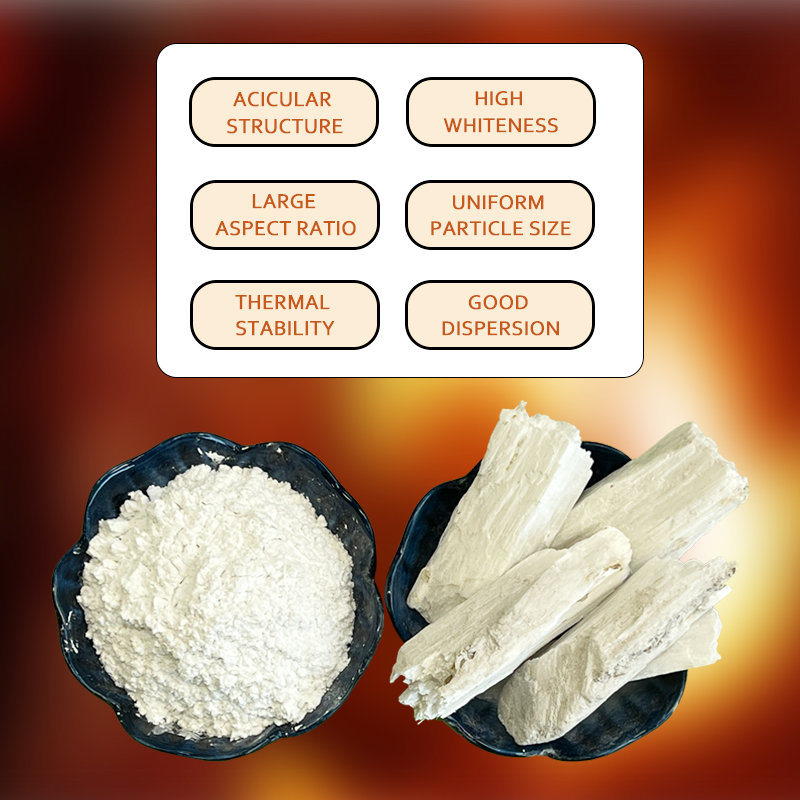Performance characteristics of wollastonite
Wollastonite belongs to the single chain silicate type ore, with the molecular formula Ca3 [Si3O9], and is generally in the form of fibers, needles, flakes, or radiation. Wollastonite is mainly white or grayish white, with a certain luster. Wollastonite has a unique crystal morphology, therefore it has good insulation, dielectric properties, and high heat and weather resistance. These properties are also the basis for determining the market application of wollastonite.
1. Coatings
Wollastonite, with its high refractive index, strong covering power, and low oil absorption, is a functional filler for building coatings, anti-corrosion coatings, waterproof and fireproof coatings. It can effectively improve the mechanical strength of coatings such as washing resistance, weathering resistance, crack resistance, and bending resistance, as well as corrosion resistance, weather resistance, and heat resistance. It is particularly suitable for producing high-quality white paint and clear and transparent colored paint; Without affecting the coverage and washability of the coating, wollastonite can replace 20% -30% titanium dioxide in the interior wall latex paint system, improve the pH value of the system, and reduce the production cost of the coating.
2. Ceramics
Wollastonite can be widely used in ceramic products such as glazed tiles, daily ceramics, sanitary ceramics, artistic ceramics, special ceramics for filtration, ceramic glaze, insulating high-frequency electric ceramics, lightweight ceramic molds, and electrical ceramics. It can improve the whiteness, water absorption, hygroscopic expansion, and resistance to rapid cooling and heating of ceramic products, making the appearance of products smoother and brighter, with increased strength and good pressure resistance. In summary, the functions of wollastonite in ceramics include: reducing the firing temperature and shortening the firing cycle; Reduce sintering shrinkage and product defects; Reduce the hygroscopic expansion of the green body and the thermal expansion during the firing process; Improve the mechanical strength of the product.
3. Rubber
Wollastonite can replace a large amount of titanium dioxide, clay, and lithopone in light colored rubber, playing a certain reinforcing role and improving the covering ability of white colorants, playing a whitening role. Especially after organic modification, the surface of wollastonite not only has lipophilicity, but also due to the double bonds of the treating agent sodium oleate molecules, it can participate in vulcanization, enhance cross-linking, and greatly enhance the reinforcing effect.
4. Plastic
The high resistance, low dielectric constant, and low oil absorption of wollastonite make its advantages in the plastic industry more obvious than other non-metallic mineral materials. Especially after modification, the compatibility of wollastonite with plastics is greatly improved, which can effectively improve plastic properties and ensure the thermal stability, low dielectric, low oil absorption, and high mechanical strength of the product. It can also reduce the cost of the product. Wollastonite is mainly used in the production of nylon, which can improve bending strength, tensile strength, reduce moisture absorption, and improve dimensional stability.
5. Paper making
Wollastonite has high refractive index and high whiteness, and as a filler, it can increase the opacity and whiteness of paper. Wollastonite is used in papermaking, and the resulting wollastonite plant fiber network has a more microporous structure, which improves the ink absorption performance of the paper. At the same time, due to the improved smoothness and reduced transparency, it increases the printability of the paper. Wollastonite interferes with the binding of plant fibers, making them insensitive to humidity, reducing their hygroscopicity and deformation, and increasing the dimensional stability of the paper. According to paper requirements, the filling amount of wollastonite varies from 5% to 35%. The whiteness, dispersibility, and leveling of ultrafine crushed wollastonite powder have been greatly improved, which can replace titanium dioxide as a paper filler.
6. Metallurgical protective slag
Wollastonite has the characteristics of low melting point, low high-temperature melting viscosity, and good insulation performance, and is widely used in continuous casting protective slag. Compared with non wollastonite protective slag, metallurgical protective slag based on wollastonite has the following advantages: stable performance and wide adaptability; It does not contain crystalline water and has a low loss on ignition; Has strong ability to adsorb and dissolve inclusions; Has good process stability; Has excellent metallurgical functions; More hygienic, healthy, and environmentally friendly; It can improve the quality and efficiency of continuous casting production.
7. Friction material
Wollastonite has needle like properties, low expansion rate, and excellent thermal shock resistance, making it an ideal substitute for short fiber asbestos. The friction materials prepared by replacing asbestos with high friction coefficient wollastonite are mainly used in fields such as brake pads, valve plugs, and automotive clutches. After testing, all performance is good, and the braking distance and service life meet relevant requirements. In addition, wollastonite can also be made into felt like mineral wool and various asbestos substitutes such as sound insulation, which can greatly reduce the use of asbestos and is beneficial for environmental protection and ensuring human health.
8. Welding electrode
Using wollastonite as a coating ingredient for welding electrodes can serve as a melting aid and slag making additive, suppress discharge during welding, reduce splashing, improve slag fluidity, make the weld seam clean and beautiful, and enhance mechanical strength. Wollastonite can also provide calcium oxide for the flux of welding rods, while bringing in silicon dioxide to obtain high alkaline slag, which can reduce burning pores and other defects at the joints. The addition amount is generally 10-20%.

Post time: Oct-23-2023

